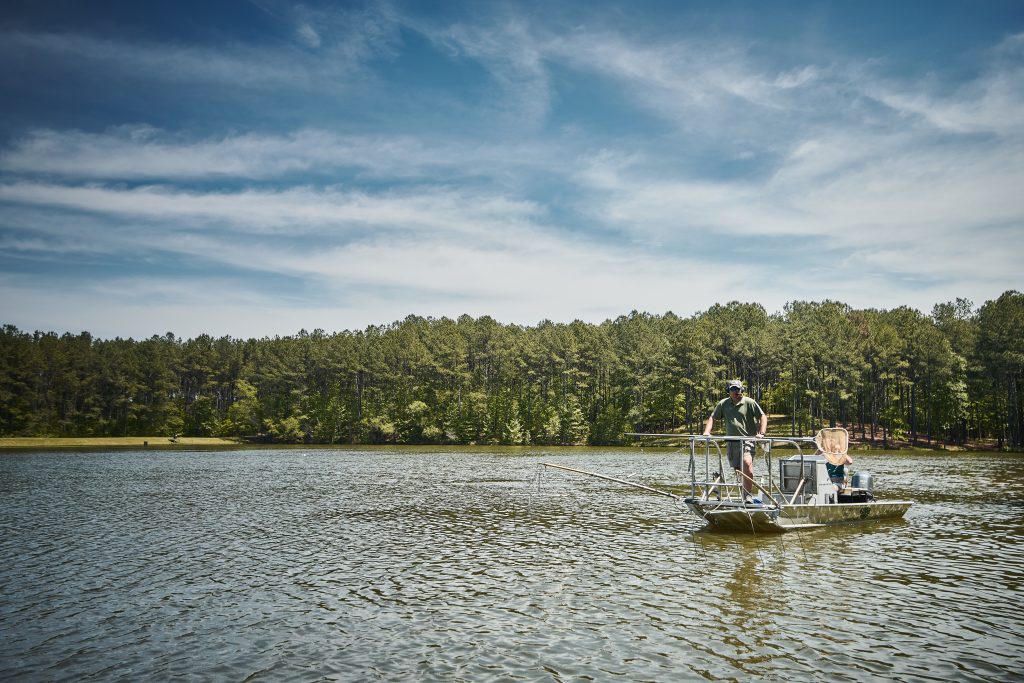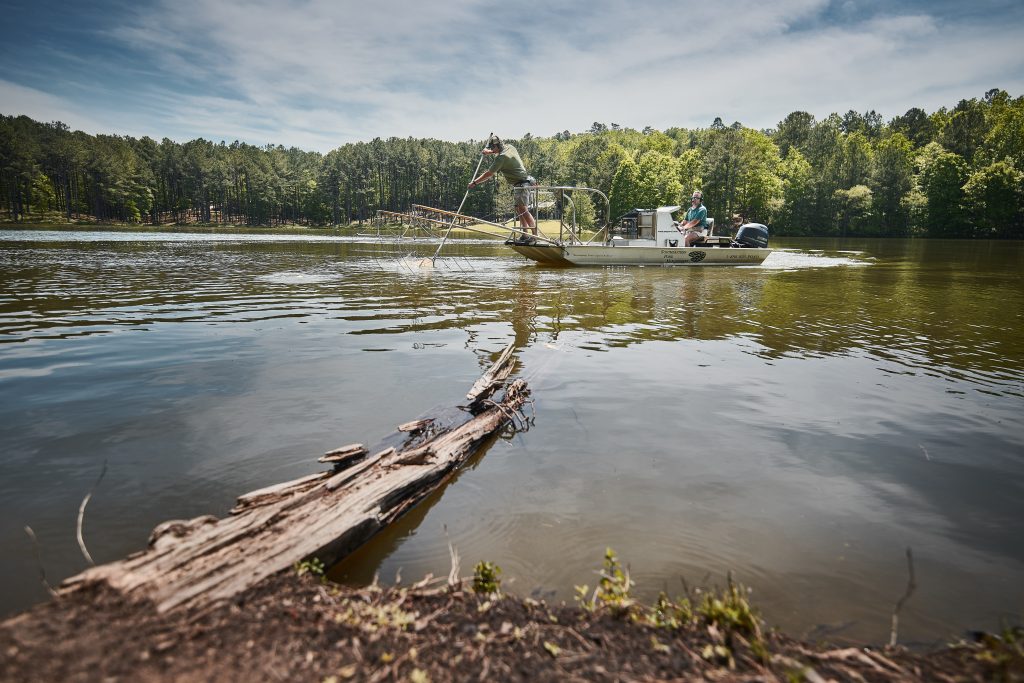Pond And Lake Restoration Step 1: Electrofishing
Scenario #1 – you own a piece of property that has a pond on it and down through the years you got busy on other things and basically let it go to seed in terms of managing it. Scenario #2 – You are seriously considering buying some dirt that has water on it and want to manage the water for some great fishing. Cutting to the quick, whether you own and are going to own property with a pond, you want to “reconstruct” that water and manage it for trophy bass. The question is where do you start and how do go through the process of pond or lake restoration? To get the inside track we went to Norm Latona, founder and president of South East Pond Management based out of Birmingham Alabama. SEPond offers a complete range of pond services ranging from pond construction and improvement, stocking, liming, fertilizing, electrofishing and getting ponds up to speed from a professional management and implication perspective.
Latona said that he gets a lot of calls from people who have “bodies of water” ranging in size to quite small up larger ponds that maybe were managed in the past or the property changed ownership but they just want to find out more about managing their ponds but don’t know where to start for pond and lake restoration.
“We get people who say, ‘hey, we got this body of water and I don’t know much about it but I kind of have an idea of what I want out of it but where do we start?’ and we almost always start with an electrofishing evaluation,” Latona said. “We need baseline information and that means making an assessment as to whether the existing fish community is suitable to maintain management.”
In addition to collecting fish data, SEPond takes water samples to determine alkalinity, Ph and overall fertility. They also visually inspect the pond and all the things that need to be in the mix.
“We obviously visually inspect the pond, the dam, the spillways, the relative abundance of fish habitat, the water depth, any aquatic vegetation, any evidence of nuisance predators, such as otters, any evidence of beavers or muskrats that might be doing damage to get as wide a perspective as possible,” Latona said. “So, when we gather all of that information and combine it with the goals and objectives of the pond owner, we create a comprehensive written management plan.”

Electrofishing an over populated pond or lake is an important step in the restoration process.
Latona explained that the lake restoration plan is very thorough, detailed that covers everything from A to Z and addresses all the topics and circumstances that relate to the pond. He then takes it a step further and offers turnkey management solutions in the form of a timeline, to implement all of the recommendations.
Let’s say a pond or lake is 20 years old and it hasn’t been managed or even fished very hard so things have gotten out of kilter. A legitimate assumption is that it is probably overpopulated with bass, none of which is very large because it probably doesn’t have many baitfish to stimulate fish growth. It is just an ignored old pond. What is the first pond or lake restoration step?
“We break it down into a couple of categories and first and foremost there are some cornerstone management inputs which are foundational to all lakes that are properly managed which over three plus decades of operation we have adopted as our basic management program,” he said.
Latona pointed out that some things are endemic in the Southeast when it comes to pond management such as liming and fertilization and the need for them can be determined quickly and easily with a simple water test.
“It is basic management 101,” Latona said. “When it comes to determining a harvest strategy, we have found that there are a lot of variables but in the majority of the time we are dealing with bass and bluegill in lakes that haven’t been limed or fertilized and pretty much neglected. Most of the time we have found that these ponds are in ‘bass crowded’ or ‘predator crowded’ condition so we make recommendations to harvest bass.”
Latona said that, when electrofishing, he usually proposes a goal of so many pounds of harvested bass per acre of water within a specific size range.
“An example might be if we have a 10-acre pond and it is bass crowded and our goal is to reduce the number of adult predators to open up forage production for the ones that remain,” Latona pointed out. “Let’s say we want to remove 40 pounds of fish per acre so that is 400 pounds total of bass that are less than 14 inches in total length. So, these are our starting points and then we can get into specific considerations that are site specific.”
A goal of removing 400 pounds of fish from that 10 acre pond every year is not a goal that is easily accomplished and certainly not just by fishing in a few weekends. To meet the objective Latona utilizes the process electrofishing a pond. While there is a cost involved, reaching that fish removal goal can be done in a matter of hours and it is a trade off with some valuable benefits.
Basically, the electrofishing equipment uses direct current electricity to draw in fish through involuntary muscle current where they are stunned.
The stunned fish can then be collected for tagging, measurement, research and even harvesting. The process doesn’t permanently harm the fish and allows you to keep the fish in your target range and release the others. It enables you to get a “profile” of your pond and identify the forage base, the predators and is a tool that you can use to manage your pond more effectively. In the case of harvesting predator bass, it is a tool to make the process more efficient.”

The key to restoring your overpopulated lake or pond is to balance out the predator to forage fish ratio.
“And we can do some other things to expedite the improvement, some of the secondary inputs such as supplemental forage stocking in the spring of threadfin shad, crawfish, intermediate size bluegills, tilapia and golden shiners which is a huge benefit,” Latona said. “That supplemental stocking, coupled with the harvest is really going to get us to the finish line.”
Latona points out that all of the inputs are interrelated and when the management plan was formulated based on the objectives of the landowner and that reaching those goals is predicated on implementing all of them.
“If you only accomplish 50 or 75% of the recommended activities typically you don’t get a corresponding level result,” Latona said. “In other words, if you do 75% of the management activities you don’t get 75% of the result and that is why we put together a management plan in the first place.”
Having outlined a plan of action to get your pond in top shape, Latona said that he has run into situations where there is just no hope of pond restoration and keeping it in a reasonable cost/benefit basis. For example, a pond may have a fish population that is completely out of whack with rough fish or competing undesirable species. Another example would be a lake that needs some physical changes such as issues with a spillway, needs the edges deepened or extensive habitat and fish structure improvements, it might make sense to start over when considering lake restoration.
“It might be easier to come in and drain, or partially drain it, kill what is there and, while the water is down get in with some equipment, do some physical improvements and just start from scratch,” Latona observed. “In addition, with starting out on a clean slate, an additional benefit is that a pond owner gets to take advantage of all the enhanced improved largemouth bass genetics. We are routinely seeing two and three pounds of growth per year.”
“It is important to remember that everything is related, that you can’t just throw a bunch of bass into a bathtub and expect them to grow for sure to three pounds all by themselves,” Latona explained. “But assuming we do everything else, right, we get the pond physically right, the liming right, we get the fertilization right, the harvest right, and get the forage stocking right, the predator stocking right and implement all of the steps we should see the bass population explode in the first couple of years.”
